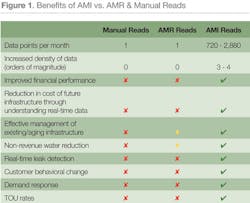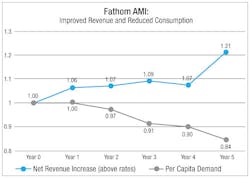Utility Alchemy: Data as the Alloying Element for Increasing Revenue and Conserving Water
By Graham Symmonds
The ancient alchemist is often depicted toiling with materials and processes in an effort to discover a mechanism that would convert ordinary metals into silver and gold -- the alchemy of creating value from nothing. For water utilities, this act is more than a metaphor -- it is a financial imperative.
Our utilities exist in a bleak financial reality in which year-over-year revenues continue to decline,1 consumption is declining,2 and continuing drought conditions are driving both groundwater and surface water supplies to critical levels.3, 4
To survive, the utility alchemist has an alloying element of tremendous power at his or her disposal: data. In fact, much of the declining revenue in utilities can be attributed to archaic data systems, where leaking data represents the majority of the non-revenue water for utilities5 and is a significant drain on both water resources and utility finances.
Using data to alloy revenue against water scarcity and decreases in demand will be a critical differentiator of utilities in the future.
Getting the Data: Advanced Metering Infrastructure
Advanced metering infrastructure (AMI) is a term used to describe metering systems that employ communication networks to deliver meter reads and other data directly to the utility. Typically, these systems collect data at 5- to 60-minute frequencies and transmit it to the utility every four to 24 hours.
While AMI systems maintain significant advantages over automated meter reading (AMR) and manual systems (see Fig. 1), notably, the value of the adoption of AMI technologies lies in filling the data voids in utility systems and obtaining highly granular, near-real-time consumption data from customers.
The lasting benefits of near-real-time data are driving significant interest in AMI platforms. However, despite the advantages of AMI over AMR and manual reading, the adoption of AMI is stalled in the marketplace. Several factors can be identified as impediments to AMI market growth, but the most important are:
- Difficulty in aligning deployment schedules with operational billing requirements
- The reality of multiple-technology configurations
- An inability of utility data systems to manage and make sense of the increased volume and velocity of data
To address these issues, technology-agnostic, data-rich platforms are necessary. However, in many cases, systems that are designed to operate with two data reads per month simply are not designed to handle the 720 to 2,880 reads that are capable of being generated by AMI systems -- nor can they be readily adapted to do so. As we connect more systems with more data, the complexity of the system increases as a function of the square of the number of interconnections. For example, expanding a platform's data nodes from 10 to 15 increases the available information by 233 percent.
This can further complicate an already complex deployment plan. However, using platforms that can gather multi-channel (manual, AMR, AMI) components eliminates the potential negative impact on utility billing during the deployment phase, and insisting on highly granular data models for data systems (meter data management, customer information systems, customer presentment systems, etc.) will ensure that the utility and customers derive maximum benefits from the data.
As the key conduit for meter-read data, it is important to have a meter data management (MDM) platform that is neither technology nor installation dependent -- that is, a platform that is capable of handling manual, AMR and AMI data simultaneously and at the same time is indifferent to specific vendors. These characteristics create a platform that is independent of the data source and the data use, supplying the necessary billing files as and when needed.
Data: The Utility Alchemist's Alloy
While many MDM platforms designed for AMR systems are not able to function in the much deeper and wider data pool that is provided by AMI, selecting a platform that is capable of receiving, normalizing and homogenizing data from disparate meter reading technologies and data sources will drive significant improvements in utility performance (see Fig. 2):
- A technology-agnostic platform provides the utility with more flexibility when it comes to implementation of an AMI program and offers more opportunities to forge the data into information.
- By improving the collection, retention, validation, and analysis of data, utilities can both encourage conservation and increase revenue.
Water Conservation
By providing customers with highly granular data, they can and do make decisions to control their costs and water consumption through proactive conservation. In many cases, customer demand reduction can be fleeting, but by combining the higher frequency and granularity of AMI data with proactive cost information from CIS, we have seen sustained impact on demand. In our experience, utilities using highly granular data have encountered a sustained per capita demand reduction of 9 percent over three years.
Improved Revenue
Normally that demand destruction would translate into decreased revenue for the utility and likely rate increases for the customers. However, by including data systems that combine geospatial customer information systems, highly granular AMI systems and technology-agnostic MDM platforms with automated data validation routines, it is possible to generate increased revenue while reducing demand.
Employing this data philosophy has generated average revenue increases of 7 to 9 percent (net of any rate increase) and in some cases revenue increases in the order of 20 percent. This is a significant benefit for our cash-strapped utilities and, in at least one case, this found revenue resulted in the deferral of a pending rate increase.
Conclusions
The near-real-time characteristics of AMI data improve revenue, reduce non-revenue water, improve customer service, and reduce the costs of billing for the utility, and can be instrumental in decreasing customer demand. Further, improved data management, an understanding of where and to whom water is flowing, effective customer engagement, and education all contribute to revenue and resource sustainability.
Removing the obstacles to AMI adoption through the use of technology-agnostic MDM platforms and deploying data systems capable of handling the vast increase in data volume and velocity will allow our utilities to enjoy all the benefits AMI provides and forge increased revenue and reduced consumption through data -- true alchemy.
About the Author: Graham Symmonds is the chief knowledge officer for FATHOM, where he impresses utility operations requirements into company products and derives knowledge for utilities from data. Formerly he served as chief technology officer and senior VP for Regulatory Affairs and Compliance for Global Water Resources, a regulated utility company in Arizona. Symmonds graduated from the University of Toronto in 1985 with a Bachelor of Applied Science degree in Mechanical Engineering and completed post-graduate studies at the Royal Naval Engineering College in Plymouth, England.
References:
1. Eskaf, S. "Are operating revenues declining for local government-owned water utilities? Evidence from six states," Environmental Finance Center at the University of North Carolina, 2013. http://tinyurl.com/crd2rpt.
2. Maupin, M.A., Kenny, J.F., Hutson, S.S., Lovelace, J.K., Barber, N.L., and Linsey, K.S. "Estimated use of water in the United States in 2010," U.S. Geological Survey Circular 1405, 56 p., 2014. http://pubs.usgs.gov/circ/1405/.
3. Castle, S.L., Thomas, B.F., Reager, J.T., Rodell, M., Swenson, S.C., Famiglietti, J.S. "Groundwater Depletion During Drought Threatens Future Water Security of the Colorado River Basin," American Geophysical Union, 2014, doi: 10.1002/2014GL061055.
4. Walton, B. "Lake Mead Drains to Record Low as Western Drought Deepens," Circle of Blue, 07 July 2014. http://www.circleofblue.org/waternews/2014/world/lake-mead-drains-record-low-western-drought-deepens/.
5. Hill, T., Symmonds, G., "The Smart Grid for Water: How Data Will Save Our Water and Your Utility," Advantage Media Group, Charleston, SC, 2013.
More WaterWorld Current Issue Articles
More WaterWorld Archives Issue Articles


